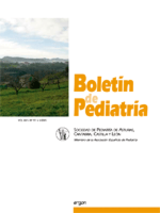Nefropatía por reflujo. Estudio de 15 años
M.C. Saura Hernández , M. Morell Contreras , J. Florín Yrabién , Y. Díaz Calderín , D.P. Durán Casal , G. González Ojeda , N. Campañá Cobas
Bol. Pediatr. 2005; 45 (191): 23 - 28
Introducción: La nefropatía por reflujo (NFR), constituye la complicación más importante del reflujo vesicoureteral (RVU). Material y método: Se estudiaron retrospectivamente 200 pacientes con RVU en un período de 15 años, en ellos se determinó el tiempo en que apareció la proteinuria, la hipertensión arterial (HTA), tipo de cicatriz y de reflujo. Resultados: El 9% de la serie estudiada (18 pacientes) evolucionaron a la nefropatía por reflujo, todos estos pacientes tenían RVU de alto grado y cuadros recurrentes de infección del tracto urinario (ITU), el 72,2% evolucionó a la NFR antes de los 5 años de evolución del RVU y de ellos el 76,1% tenían RVU secundario. La proteinuria se observó en el 100% de los casos, asociado, en ocasiones, a la HTA. Conclusiones: La presencia de cicatrices renales bilaterales en pacientes con reflujo vesicoureteral de alto grado, con infecciones urinarias recurrentes, unido a malformaciones del tracto urinario, representan los factores fundamentales que se relacionan con la aparición de la nefropatía de reflujo; constituye la proteinuria un elemento precoz y constante en pacientes que desarrollan una nefropatía por reflujo, la cual, unida a la hipertensión arterial, constituye un riesgo importante en el deterioro de la función renal en estos pacientes. Abstract Introduction: Reflux nephropathy (RN) is the main complication of vesicoureteral reflux (VUR). Material and methods: A retrospective study of 200 patients with VUR was made during 15 years. The time when proteinuria appeared, arterial hypertension, kind of scar and of reflux were determined. Result: Nine percent of the patients (18 individuals) developed RN, all of them had high grade VUR and also had frequent episodes of urinary tract infections (UTI). Seventy two percent of patients developed RN during the first five years after the diagnosis of VUR and 76.1% of them had secondary VUR. Proteinuria was observed in 100% of patients and it was accompanied by arterial hypertension in some patients. Conclusions: Bilateral renal scars in patients with high grade VUR, recurrent UTI associated to urinary tract malformations are the main risk factors for the developing of RN. Proteinuria is a constant and early element in patients with RN, and together with arterial hypertension are risk factors for the deterioration of renal function in these patients.
\N
\N
Artículo completo (PDF) (75 kb.)
- Nefrourología
Buscar en el boletín
Año 2005, Volumen 45, Número 191

Boletín completo en PDF (704 kb.)
En esta edición...
- Editorial (1 artículos)
- Revisiones (1 artículos)
- Originales (2 artículos)
- Casos clínicos (2 artículos)
- Pediatría e Internet (1 artículos)
- Hace 25 años (1 artículos)
- Crítica de libros (1 artículos)
- En la jubilación (1 artículos)
- XVII Memorial Arce - Sánchez Villares (1 artículos)
- Noticiario (1 artículos)
- Fe de erratas (1 artículos)